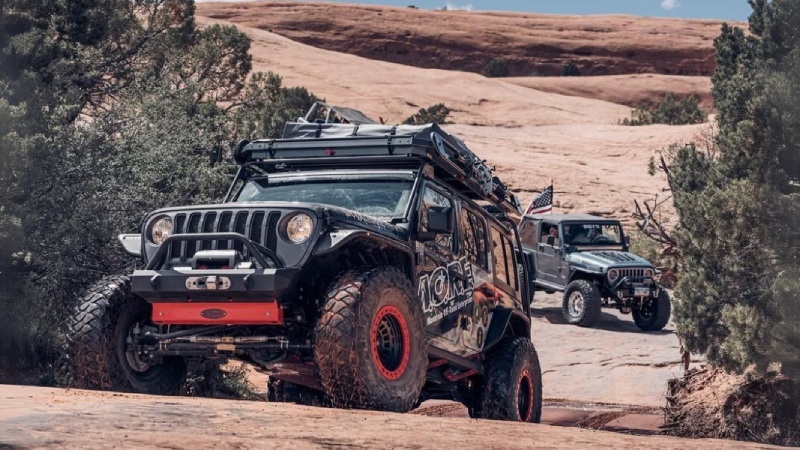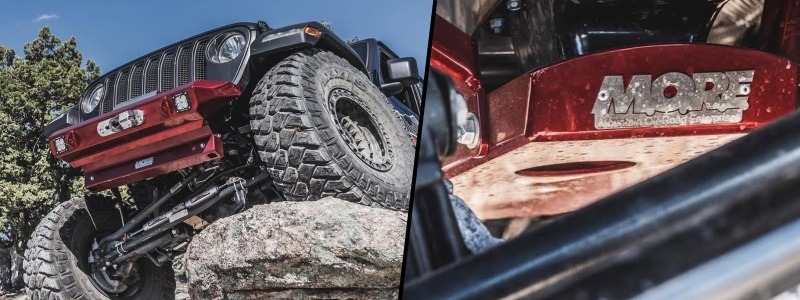Overview
So, you finally got your Toyota or that dream Jeep, and you’re itching to hit the trails. But let’s be real… just because a vehicle has “off-road” in its name doesn’t mean it’s truly built for rugged terrain. Factory models come with compromises, and relying on stock parts can turn an epic adventure into a frustrating repair bill. Should you upgrade right away? Are aftermarket parts for Jeep and Toyota really necessary, or just an expensive hobby?
At Mountain Off-Road, we’ve spent decades helping off-roaders build vehicles that don’t just survive the trails but conquer them. In this guide, we’re cutting through the noise and exposing misconceptions about aftermarket jeep parts. You’ll learn which upgrades matter most, how to avoid costly mistakes, and what separates essential mods from marketing fluff. Whether you’re a beginner or a seasoned explorer, this is your roadmap to a better, more capable rig.
Table of Contents
- The Truth About Aftermarket Parts – Who Really Needs Them?
- Why Stock Vehicles Aren’t as Trail-Ready as You Think
- Off-Roading vs. Overlanding – Choosing the Right Upgrades
- Beginner Mistakes That Can Cost You Big
- Building a Rig That’s Ready for Any Adventure

Are Aftermarket Parts Only for Hardcore Off-Roaders?
There’s a common myth that aftermarket parts for Jeep and Toyota are only for rock crawlers and extreme off-road junkies. But let’s be real—off-roading isn’t just about conquering Moab or charging through deep mud pits.
Plenty of everyday adventurers need off-road vehicle modifications beginners to make their rigs safer and more capable. Maybe you’re taking the family on a camping trip deep into the mountains. Maybe you just want a smoother ride on washboard trails. Or maybe you’re tired of your stock bumpers taking a beating every time you hit a rough patch. Best Jeep upgrades for durability, like skid plates or better suspension, aren’t just for hardcore wheelers—they’re for anyone who doesn’t want to get stranded in the middle of nowhere.
Now, if you only use your rig for grocery runs and the occasional road trip, you’re probably fine with stock parts. But if you plan on venturing off the pavement—whether it’s light overlanding, beach driving, or backcountry exploring—there’s a good chance you’ll need budget-friendly off-road mods to prevent costly damage and make your adventures stress-free.
“My Jeep or Toyota Comes with Everything I Need”—Think Again
Automakers do a great job marketing their vehicles as “off-road ready,” but let’s talk facts. When a manufacturer builds a vehicle, it’s designed to handle a little bit of everything—highway driving, city streets, and maybe a bit of dirt. What it’s not built for is serious trail punishment. Comparing stock vs aftermarket parts makes it clear: factory skid plates are often thin and don’t cover key components, stock bumpers prioritize looks over function, and suspension systems are tuned for comfort over capability.
That’s why Toyota Tacoma suspension upgrades and Jeep Wrangler suspension upgrade guide searches are so popular—because drivers quickly realize that even “off-road” trims like the TRD Pro or Rubicon still have their limits. You don’t need to go all-in with a full custom build, but making a few smart upgrades can mean the difference between an easy recovery and a costly tow.
Where Stock Vehicles Fall Short on Tough Terrain
Imagine this: You’re tackling a rocky trail, and suddenly you hear that gut-wrenching scrape of metal against stone. Congratulations—you just found out why how to choose skid plates for Jeep is a thing. Stock vehicles often lack proper underbody protection, leaving critical parts exposed to damage.
Or maybe you’re in soft sand, struggling for traction. That’s when you realize why off-road tires comparison guide searches are full of people swapping out their factory all-seasons for something with real grip. Stock tires might handle wet pavement, but they won’t do you any favors in deep mud or loose gravel.
And let’s not forget clearance. Whether you’re in a Toyota off-road build or a Jeep, factory suspension can leave you scraping over obstacles that an upgraded rig would glide over. That’s why many drivers start with how to upgrade Jeep for off-road before they ever hit serious trails. A few well-chosen mods can be the difference between powering through an obstacle and waiting for a buddy with a winch to bail you out.
Off-Roading vs. Overlanding—How the Right Mods Make the Difference
Off-roading and overlanding both push vehicles beyond the pavement, but they demand different setups. Off-road vehicle performance enhancement is all about tackling rough terrain—think steep inclines, deep ruts, and technical rock crawling. That’s why rock sliders for Jeep and skid plates are crucial to protect against underbody damage. Overlanding, on the other hand, is more about endurance—long-distance travel with everything you need packed into your rig. It’s why overlanders focus on Toyota upgrade guide recommendations like suspension upgrades, extra fuel capacity, and onboard power solutions.
Some modifications work for both worlds. A solid skid plate installation guide applies whether you’re rock crawling or taking on remote desert trails. Tacoma off-road accessories like roof racks and light bars help in both cases—though an off-roader might use them for better visibility at night on the trails, while an overlander uses them for setting up camp. The key is knowing what’s necessary for your style of adventure and avoiding unnecessary mods that add weight and cost without real benefits.
Recovery Gear Essentials for Every Type of Adventure
No matter what kind of off-road adventures you prefer, one fact remains: things will go wrong. The difference between a minor inconvenience and a full-blown disaster is having the right best recovery gear for off-road adventures on hand. At a minimum, every driver should carry a recovery strap, shackles, and a shovel. If you’re venturing into mud, sand, or snow, a set of traction boards is a lifesaver. And if you’re serious about getting deep into the wild, a winch should be at the top of your gear list.
For those exploring alone or in remote areas, self-recovery becomes even more critical. That’s why many Jeep off-road upgrades include winch-ready bumpers and high-lift jacks. Overlanders, meanwhile, often pack air compressors for airing down and back up, making tire pressure adjustments easy on changing terrain.
First Jeep Mods & Essential Toyota Upgrades for Off-Roading
Jeep Mods: Trail-Tested Essentials
Jeeps have a legendary reputation, but even a Rubicon straight from the dealership has room for improvement. The first upgrades most owners go for are Jeep Gladiator first mods like better tires, upgraded skid plates, and a more durable front bumper with recovery points. Off-road modifications on a budget often start with disconnecting sway bars for better articulation and adding rock sliders for protection.
Another common issue is steering stability—bigger tires and tough trails put stress on stock components. A Jeep modification tips list would be incomplete without mentioning a steering stabilizer upgrade, which helps reduce bump steer and improves control.
Toyota Upgrades: Built for Long Hauls and Tough Trails
Toyota trucks and SUVs have built a reputation for reliability, but stock components still have their limits. For 4Runner owners tackling rough trails, upgrading to reinforced lower control arms and adding skid plate installation guide recommendations for better undercarriage protection are common first steps. Many enthusiasts in the Toyota off-road build community also choose lift kits to improve ground clearance and approach angles on rocky terrain.
For Tacoma owners, protection and durability are top priorities. Upgrading with Tacoma off-road accessories like rock sliders and aftermarket bumpers helps prevent body damage on technical trails. Those carrying extra weight—whether it’s overlanding gear or recovery equipment—often turn to Toyota Tacoma suspension upgrades to reduce strain on factory shocks and maintain ride quality on long-distance adventures.
Best Off-Road Upgrades for Overlanding
Jeep Overland Mods: Comfort Meets Capability
Overlanding in a Jeep is about balance—you need comfort for long miles and capability for when the road gets rough. Durable aftermarket parts for off-roading like upgraded suspension, all-terrain tires, and a rooftop tent setup are common first steps. Adding extra off-road vehicle performance enhancement mods like auxiliary lighting, solar panels, and additional fuel storage helps turn a Jeep into a true long-haul explorer.
Toyota Overland Mods: Built for the Long Haul
Toyota’s overlanding popularity comes from its ability to go anywhere and stay there for days. Many Toyota upgrade guide recommendations focus on self-sufficiency—dual battery setups, roof racks for additional storage, and onboard air compressors for maintaining tire pressure. Benefits of overlanding come down to preparation, and Toyotas are among the best platforms for fully outfitted overland rigs.
Whether you’re tackling hardcore trails or exploring remote landscapes, the right upgrades make all the difference. Knowing what works for off-roading, what’s better for overlanding, and where they overlap ensures your build fits your adventure style.

Common Mistakes in Vehicle Modifications & How to Avoid Them
Modifying your rig can be exciting, but beginners often make costly mistakes. Some upgrades add real value—others? Not so much. Here’s what to watch out for.
Buying Mods You Don’t Actually Need
Just because an upgrade looks cool doesn’t mean it’s right for your build. Best upgrades for off-road vehicles should match your terrain and driving style. Overlanders prioritize reliability and storage, while rock crawlers focus on clearance and traction.
Choosing the Wrong Aftermarket Parts
Not all aftermarket parts for Toyota and Jeep are built the same. “Assembled in the USA” isn’t the same as “Made in the USA”—the latter typically guarantees better durability. Quality matters when your rig is on the line.
Skipping the Basics
Before adding flashy mods, handle the essentials: off-road safety tips for beginners start with better tires, a solid suspension, and basic recovery gear. A winch won’t help if your suspension bottoms out on the first obstacle.
Final Thoughts – Making the Right Choice for Your Off-Road Adventure
Whether you’re fine-tuning a Toyota off-road build or upgrading your Jeep, smart modifications make all the difference. Understanding aftermarket modifications helps avoid costly mistakes and ensures your rig is truly trail-ready. Choose wisely, and every adventure will be worth the ride.